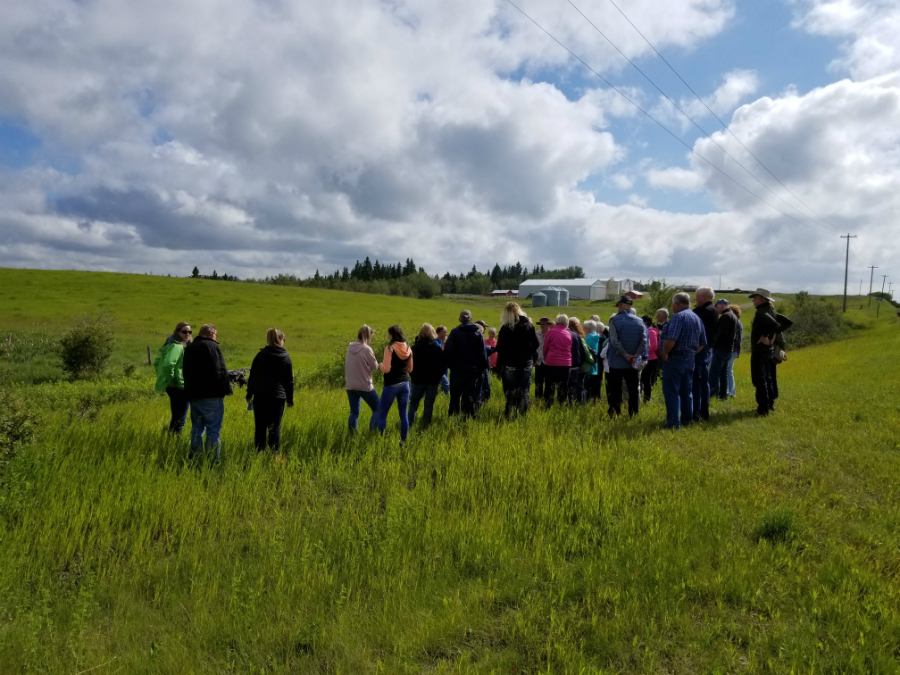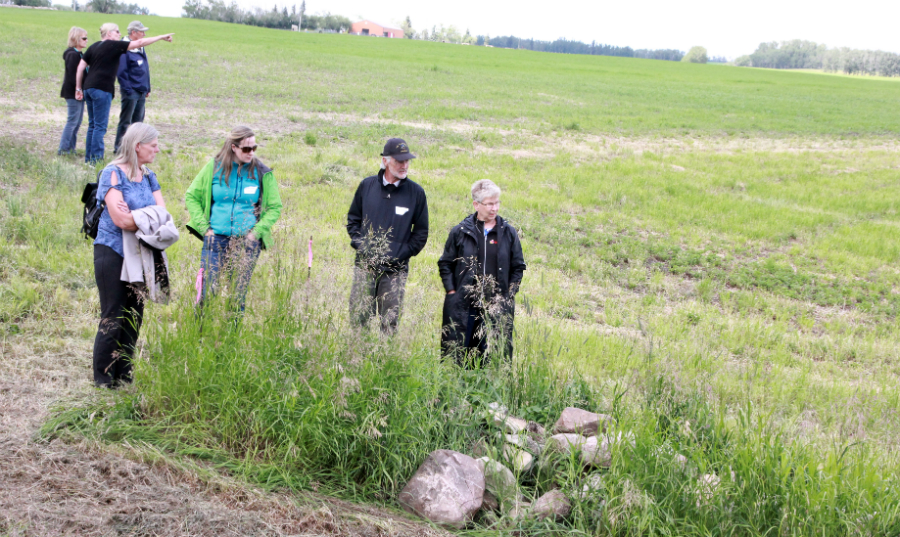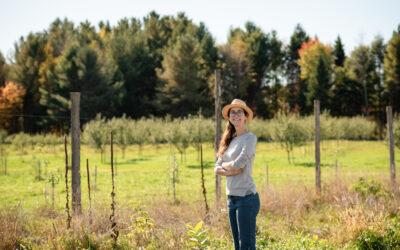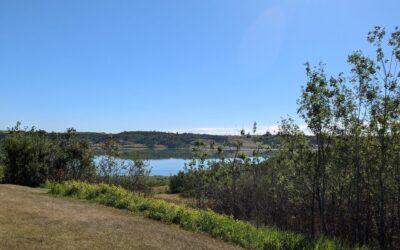ALUS Lacombe County hosted their first-ever public tour in July 2018

A great time was had by all on the ALUS Lacombe tour, celebrating the first year of this program. (Photo: Kim Barkwell)
ALUS is making great strides in Lacombe County. The ALUS Lacombe County program only came into being in January 2017, and yet they were ready to host their first-ever public tour of ALUS projects in their community on July 4, 2018.
During ALUS Lacombe County’s first year of operation in 2017, four farmers and ranchers signed up to participate, together enrolling 97 acres into the program. The 2018 tour showcased three of these ALUS project sites, located in the beautiful plains of central Alberta.
Program Coordinator Jalene Makus welcomed a large group of 52 people from for a full-day visit of ALUS projects as great examples of ALUS Lacombe County program’s top priorities: the conservation and enhancement of waterways, wetlands and forested areas to improve water quality in local lakes.
“The aim of this event was to show the public what we are doing with the ALUS program in Lacombe County, and get more people interested in participating,” said Makus. “I think getting people out to see the ALUS projects on the ground really encourages people to come forward with their own project ideas.”
The majority of the people in attendance were local landowners, who joined with coordinators of other ALUS programs in Alberta such as Kim Barkwell of ALUS Wetaskiwin-Leduc, as well as ALUS Lacombe PAC members, Lacombe County councilors and staffers, the Red Deer River Watershed Alliance, and representatives of other communities interested in ALUS such as Rocky View County.
At the first stop on the tour, the group visited ALUS participant Roger Marcil. After expanding his parents farm in 1982, Roger now enjoys being semi-retired and farming 480 acres of land as Marcil Farms.

ALUS Lacombe participant Roger Marcil describes his ALUS wetland-protection project and the duck nesting structures he maintains to boost waterfowl habitat.
For their first project, the Marcils enrolled eight acres situated around a wetland into the ALUS program. They converted six of these acres from annual cropland to perennial hay, and planted 200 native trees (poplar, spruce and red osier dogwood) in the remaining two acres.
In just one year, these ALUS projects have helped to reduce sediment in the wetland and produce cleaner water, cleaner air and excellent wildlife habitat.
“Roger recognizes the value on wildlife on the landscape,” said Makus. During the tour, Roger brought a duck hen house out of the wetland to demonstrate its construction and maintenance to the group.
Next, the tour visited Ted and Betty Everenden in Bentley, Alberta, who are maintaining an eight-acre ALUS project to fight soil erosion.
“Before we put in this ALUS project, there was quite a lot of soil which nearly filled up the culvert during the spring runoff—we saw our soil in the highway intersection a kilometre away!” said Betty Everenden.
“We seeded this area back into perennial forage to combat soil erosion, and one year later, the runoff is clear, with no visible soil displacement.”

“We seeded this area back into perennial forage to combat soil erosion, and one year later, the runoff is clear, with no visible soil displacement,” said ALUS Lacombe participant Betty Everenden
For the last stop on the tour, the group visited Rob Williams, another of ALUS Lacombe County’s first-ever participants, who showcased a fascinating ALUS project known as an eco-buffer.
This 1,200 metre long strip contained 6,500 seedlings of prickly rose, raspberry, wolf willow, red osier dogwood, white birch and other species, which were planted in cooperation with the AgroForestry and Woodlot Extension Society (AWES).
When it is mature, the eco-buffer will provides wildlife habitat and a windbreak around the perimeter of the farm.
Williams values both wildlife and water on the landscape.
“I lived in Texas for 25 years,” Williams recalls, “and the preoccupation there was to keep water ON your land. Here in Alberta, people try to move water OFF their land as quickly as possible. Texas is nice, but don’t want Canada to become dry like Texas!”

When it is mature, this 1,200 metre ecobuffer will provide wildlife habitat and a windbreak around the perimeter of ALUS Lacombe participant’s Rob Williams’ farm. It contains 6,500 seedlings of native woody species, like prickly rose, raspberry, wolf willow, red osier dogwood and white birch. (Photo: Kim Barkwell)
Overall, a great time was had by all on the ALUS Lacombe tour, celebrating the first year of the program.
“It was a great first year for us,” said Makus. “We are proud to show everyone some of the great projects we established in 2017, and we are looking forward to growing this program even more. Each of these ALUS projects will lead to significant environmental impacts for the County as a whole.”



